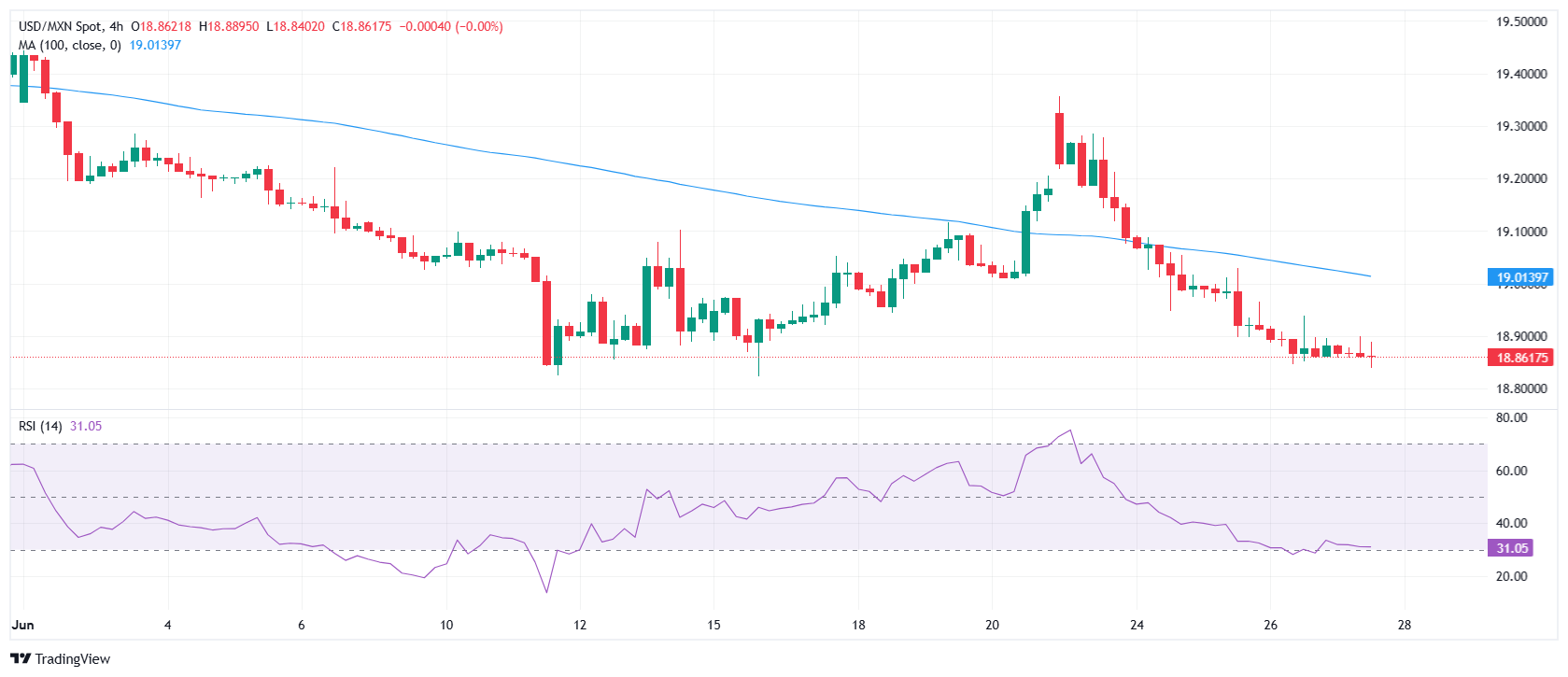- The USD/MXN falls to a minimum of 16 days in 18.84.
- The US dollar continues to weaken by Trump’s attacks to Powell.
- Banxico cut the interest rates 50 basic points and pointed out that the next cuts will depend on the data.
- The underlying inflation of the US PCE raises more than expected in May.
The USD/MXN records losses per fifth consecutive day this Friday, sliding to a new minimum of 16 days in 18,8402, where it quotes losing 0.08% in the day after the opening of Wall Street.
The announcement of agreement between the US and China and Trump’s attacks on the Fed weakens the dollar
The American dollar index (DXY) continues to show losses at the gates of the weekend, again testing the minimum of three years reached yesterday in the 97.00 zone. The green ticket weakened again after Donald Trump announced last night that an agreement with China was signed on Wednesday, also anticipating a possible covenant with India. The news reinforced the risk appetite of a market that remains optimistic from Alto El Fuego between Israel and Iran. To this are added the continuous attacks of President Donald Trump to the Fed. On Thursday, the US President described Jerome Powell, head of the Federal Reserve, as ‘terrible’. In addition, the market fears Trump to announce in September or October the name of the person who will replace Powell in May of next year, which arouses fears for the possible loss of independence of the Central Bank.
This Friday, the US has published several relevant data, which have not managed to get the dollar, despite showing a positive bias for a rebound in the currency. In the first place, the underlying inflation of the PCE, the preferred inflation measure of the FED, rose 2.7% per year in May, above the expected 2.6%, while the April data was reviewed upwards, from 2.5% to 2.6%. Secondly, the index of the consumer’s feeling at the University of Michigan has increased to 60.7 points in June since May 52.2, obtaining its best figure in four months. The data has exceeded the forecasts, which expected an increase at 60.5.
Banxico cuts interest rates at 8% while Mexican unemployment rises to 2.7% in May
At the last minute of Thursday, Banxico announced that he reduced his interest rates at 50 basic points up to 8%, his lowest level from June 2022. In the monetary policy statement, the entity highlighted upward risks for inflation, and although he pointed more cuts in the future, he clarified that they would depend on the data, which helped the Mexican weight to maintain its current strength.
After the announcement of the Central Bank of Mexico, today Friday, the country’s unemployment fact has been published, showing an increase of two tenth to 2.7% in May. The figure worsens the forecasts, since the consensus provided for it to be maintained at 2.5%.
USD/MXN Price levels
The relative force index (RSI) shows that the USD/MXN is oversight in the 4 -hour graph, so we could see a brief rebound in the next few hours. In wider periods of time, there is room for more falls. If this rebound occurs, you will find resistance in the mobile socks of 100 in one and four hours graph, around 18.97 and 19.01. Above, the main resistance is located in 19.35, maximum of the week registered on June 23.
In southern direction, the main support is at a minimum of 2025 reached in mid -June in 18.82. A rupture of this ground could cause a decrease to the 18.60 area, where the 10 -month floors are registered at the end of August.
USD/MXN 4 -hour graphic

Mexican weight FAQS
The Mexican weight (MXN) is the most commercialized currency among its Latin American peers. Its value is widely determined by the performance of the Mexican economy, the country’s central bank policy, the amount of foreign investment in the country and even remittance levels sent by Mexicans living abroad, particularly in the United States. Geopolitical trends can also affect MXN: for example, the Nearshoring process (or the decision of some companies to relocate the manufacturing capacity and supply chains closer to their countries of origin) is also considered a catalyst for the Mexican currency, since the country is considered a key manufacturing center in the American continent. Another catalyst for MXN is oil prices, since Mexico is a key exporter of the raw material.
The main objective of the Central Bank of Mexico, also known as Banxico, is to maintain inflation at low and stable levels (in or close to its 3%target, the midpoint of a tolerance band between 2%and 4%). To do this, the bank establishes an adequate level of interest rates. When inflation is too high, Banxico will try to control it by raising interest rates, which makes the indebtedness of homes and companies more cooling, thus cooling the demand and the economy in general. The highest interest rates are generally positive for Mexican weight (MXN), since they lead to higher yields, which makes the country a more attractive place for investors. On the contrary, lower interest rates tend to weaken the MXN.
The publication of macroeconomic data is key to evaluating the state of the economy and can have an impact on the valuation of the Mexican weight (MXN). A strong Mexican economy, based on high economic growth, low unemployment and high confidence is good for MXN. Not only attracts more foreign investment, but it can encourage the Bank of Mexico (Banxico) to increase interest rates, particularly if this fortress is accompanied by high inflation. However, if the economic data is weak, the MXN is likely to depreciate.
As an emerging market currency, the Mexican weight (MXN) tends to rise for periods of risk, or when investors perceive that the general market risks are low and, therefore, are eager to participate in investments that carry a higher risk. On the contrary, the MXN tends to weaken at times of market turbulence or economic uncertainty, since investors tend to sell higher risk assets and flee to the most stable safe shelters.
Source: Fx Street
I am Joshua Winder, a senior-level journalist and editor at World Stock Market. I specialize in covering news related to the stock market and economic trends. With more than 8 years of experience in this field, I have become an expert in financial reporting.







